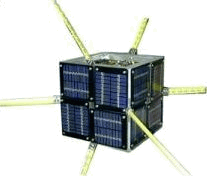Navy-OSCAR 44 (PCSat)
 Launched September 30, 2001 from the Kodiak Launch Complex on Kodiak Island, Alaska aboard Athena I. Kodiak Star was the first planned orbital launch from the new Kodiak Launch Complex in Alaska was a NASA collaborative mission with the Department of Defense (DoD). The payload consisted of four small satellites, Starshine 3, PICOsat, PCSat, and SAPPHIRE, were launched aboard a Lockheed Martin Athena I launch vehicle. PCSat is a 1200-baud APRS digipeater designed for use by stations using hand-held or mobile transceivers. Downlinks feed a central web site http://pcsat.aprs.org. The APRS-equipped PCSat was built by midshipmen from the U.S. Naval Academy.
Launched September 30, 2001 from the Kodiak Launch Complex on Kodiak Island, Alaska aboard Athena I. Kodiak Star was the first planned orbital launch from the new Kodiak Launch Complex in Alaska was a NASA collaborative mission with the Department of Defense (DoD). The payload consisted of four small satellites, Starshine 3, PICOsat, PCSat, and SAPPHIRE, were launched aboard a Lockheed Martin Athena I launch vehicle. PCSat is a 1200-baud APRS digipeater designed for use by stations using hand-held or mobile transceivers. Downlinks feed a central web site http://pcsat.aprs.org. The APRS-equipped PCSat was built by midshipmen from the U.S. Naval Academy.
Orbital Parameters
Name NO-44 NORAD 26931 COSPAR designation 2001-043-C Inclination (degree) 67.051 RAAN 222.994 Eccentricity 0.0004982 ARGP 275.487 Orbit per day 14.29468105 Period 1h 40m 44s (100.73 Min) Semi-major axis 7172 km Perigee x apogee 790 x 797 km Drag factor 0.000100350 1/ER Mean anomaly 84.567
Downlink
145.825 MHz (FM,FSK, AX.25 1k2 and 9k6)
Uplink
145.825 MHz (FM,FSK, AX.25 1k2 and 9k6)
Antenna polarisation
unknown
Callsigns
PCSAT-1,PCSAT-11, PCSAT-12, PCSAT-2, W3ADO-1
Digipeater: ARISS
Digipeater: PCSAT-1
Digipeater: W3ADO-1
Digipeater: WIDE
Telemetry
Fm W3ADO-1 To BEACON Via SGATE [19:22:28] T#655,127,125,071,100,213,11111111,0010,1 Fm W3ADO-1 To BEACON Via SGATE [19:23:09] T#657,029,050,059,080,213,11111110,0000,1 Fm W3ADO-1 To BEACON Via SGATE [19:24:48] T#662,128,124,136,116,213,11111111,0001,1 Fm W3ADO-1 To BEACON Via SGATE [19:27:48] T#671,117,125,178,097,213,11111111,0010,1 Fm W3ADO-1 To BEACON Via SGATE [19:31:09] T#681,035,050,058,044,213,11111111,0000,1
Status
NO-44 operates in a negative power budget meaning it comes alive in mid-day sun on every orbit but fully runs down its batteries 45 minutes later in the next eclipse. It has to be in sun long enough to get enough charge to be able to provide the peak transmit power for the packet transmitter. If it tries to transmit with insufficient battery charge, the battery voltage drops and the TNC again resets. Users may use the transponder when they think it will respond. Twice a year during full sun, we are able to fully recover the satellite and then it will operate normally for a few weeks until the first reset which will put it back power negative again.
30-July-2015 – Update: NO-44 could be interfering on 144.390 over Europe.
So sorry, but yes. “Houston, we have a small problem…” I hate to say it, but that beacon was IARU coordinated 15 years ago for operation only when NO-44 (PCSAT) is over North America, but after 14 years on orbit, we have lost the ability to turn that backup beacon off.
PCSAT (now 14 years old) had a backup fail-safe beacon on 144.39 that would activate after any unknown spacecraft reset to give us a backup comm link in case the primary 145.825 channel died. Being on the North American APRS frequency with hundreds of iGates there would always be at least one that would hear this “emergency call home” from NO-44 (PCSAT) even though the channel is generally saturated. And it worked.
The problem is, that now NO-44 (PCSAT) resets on every orbit due to negative power budget and so, on every orbit that beacon comes back on. Even if we did get a command up to reset it, that setting would last only 15 minutes to the next eclipse.
We learned our lesson! That was our FIRST amateur satellite and we sure learned NOT to use a “connected-packet-command link” that needs ACKS and Retries and logon passwords just to LOGON before you can even send a SHUTUP command. All our satellites since, operate without the multiple Send, connect, ACK, retry, ACK, command, ACK overhead…. just to get one command understood. Now, only the receiver on the spacecraft has to be functional to command it to silence in a single packet. But too late for PCSAT.
We are sorry that we have no good answers. But we hope we can mitigate this instance of “friendly fire” collateral damage so that we don’t cause an overall black-eye to amateur radio overall friendly operations?
What you may hear will be 2 one-second packets per minute, one at 1200 baud and one at 9600 baud, trying to “call home”.
Bob, WB4APR (Naval Academy)
Homepage and other references:
NO-44/PCSat Main website
